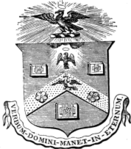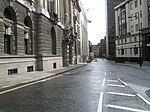Paternoster Vents
2002 establishments in England2002 sculpturesBuildings and structures in the City of LondonOutdoor sculptures in LondonStainless steel sculptures ... and 1 more
Steel sculptures in England

Paternoster Vents, often referred to as simply Vents and also known as Angel's Wings, is an outdoor 2002 stainless steel sculpture by Thomas Heatherwick, installed at Paternoster Square in London, United Kingdom. The sculpture provides ventilation for an underground electrical substation.
Excerpt from the Wikipedia article Paternoster Vents (License: CC BY-SA 3.0, Authors, Images).Paternoster Vents
Bishop's Court, City of London
Geographical coordinates (GPS) Address External links Nearby Places Show on map
Geographical coordinates (GPS)
| Latitude | Longitude |
|---|---|
| N 51.514339 ° | E -0.100462 ° |
Address
Angel's Wings
Bishop's Court
EC4M 7BQ City of London
England, United Kingdom
Open on Google Maps










